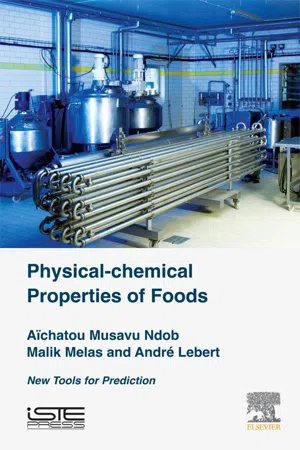
Physical-Chemical Properties of Foods
New Tools for Prediction
- 106 pages
- English
- ePUB (mobile friendly)
- Available on iOS & Android
Physical-Chemical Properties of Foods
New Tools for Prediction
About this book
The physical and chemical properties of food products have central roles in biotechnology and the pharmaceutical and food industries. Understanding these properties is essential for engineers and scientists to tackle the numerous issues in food processing, including preservation, storage, distribution and consumption.This book discusses models to predict some of the physical-chemical properties (pH, aw and ionic strength) for biological media containing various solutes. In recent years, food production has involved less processing and fewer additives or preservatives. If health benefits for consumers are obvious, it is not only necessary to adapt current processing and preservation processes but also to verify that appropriate technological and health properties are preserved.The authors present established models, but also introduce new tools for prediction with modeling methods that are part of a more general approach to understand the behavior of fluid mixtures and design new products or processes through numerical simulation.- Describes the construction of a tool to allow you to predict the physical-chemical properties of foods and bacterial broths- Shows you how to apply this tool with complex medias to predict water activity and pH levels and how to integrate this tool with a process simulator- Full with theoretical equations and examples to help you apply the content to your data
Frequently asked questions
- Essential is ideal for learners and professionals who enjoy exploring a wide range of subjects. Access the Essential Library with 800,000+ trusted titles and best-sellers across business, personal growth, and the humanities. Includes unlimited reading time and Standard Read Aloud voice.
- Complete: Perfect for advanced learners and researchers needing full, unrestricted access. Unlock 1.4M+ books across hundreds of subjects, including academic and specialized titles. The Complete Plan also includes advanced features like Premium Read Aloud and Research Assistant.
Please note we cannot support devices running on iOS 13 and Android 7 or earlier. Learn more about using the app.
Information
The Main Physical-chemical Properties
Abstract
1.1 Physical-chemical properties and qualities of biological products
Table of contents
- Cover image
- Title page
- Table of Contents
- Copyright
- Introduction
- 1: The Main Physical-chemical Properties
- 2: A Thermodynamic Approach for Predicting Physical-chemical Properties
- 3: Applications to Biological Media
- 4: Usage in Process Simulators
- Conclusion: The Extensions of the Thermodynamic Approach
- Appendix 1: The UNIFAC Model
- Appendix 2: Debye–Hückel Expression for Long-Range Interactions
- Appendix 3: Solvation Equations
- Appendix 4: List of Functional Groups
- Appendix 5: Parameters of Interaction Between Functional Groups
- Bibliography
- Index